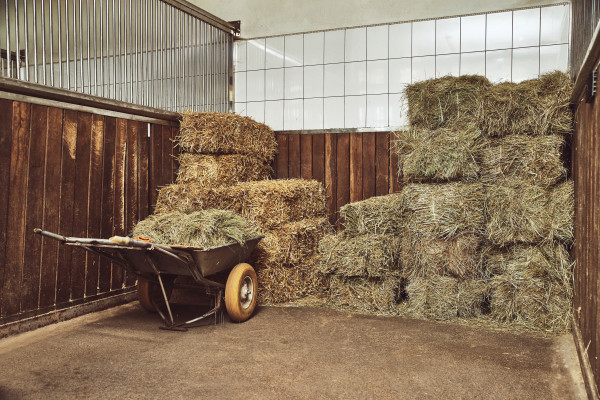Home > Horse Care > Preparing for next season’s hay
Preparing for next season’s hay
- April 30, 2024
- ⎯ Christine Barakat with Melinda Freckleton, DVM
It may seem as if pastures have only just started growing, but before long it will be time to buy hay. When your hayloft or shed is at its emptiest this spring, spend an afternoon preparing it for the next shipment.

• Remove all remaining bales from the space, giving each a good sniff for mold as you go. Molding bales tend to be heavier than the rest so give those that are harder to lift an extra look. Discard any bales that are questionable.
• Sweep the entire area clean, looking for wet or discolored spots on the floor that may signal leaks in the roof or other parts of the structure. Shut the door and then look up at the ceiling: Tiny beams of sunlight streaming in will reveal pinholes in the roof. Patch any problem areas or make arrangement to replace the roof entirely.
Click here to learn more about anemia in horses.
• Be alert for signs of rodent infestation as you sweep. These could be droppings, nesting materials or gnaw marks around the perimeter of the area. If you think you have an infestation, wear gloves and a facemask to protect your health as you clean—rodents can carry many pathogens that may be passed to humans. A motivated cat or terrier in residence can help address a rodent problem, as can a blacksnake. Otherwise, your best bet is to vow to keep a tidier space, cleaning up any grain spills immediately.
• Repair or replace broken pallets if you stack hay on them. Likewise, inspect any tarps you use to keep moisture from wicking from walls and floors onto bales, and repair or replace them as necessary.
• Check the integrity of doors and windows, ensuring they close completely. If you don’t already have a horse-proof latch on the main door, consider adding one.
• Restack leftover hay from the previous year to the front and side of the space where it is easy to access, leaving room to place the new shipment toward the back. Nutrients in hay degrade over time, so you don’t want any bales left uneaten longer than necessary.
Don’t miss out! With the free weekly EQUUS newsletter, you’ll get the latest horse health information delivered right to your in basket! If you’re not already receiving the EQUUS newsletter, click here to sign up. It’s *free*!





